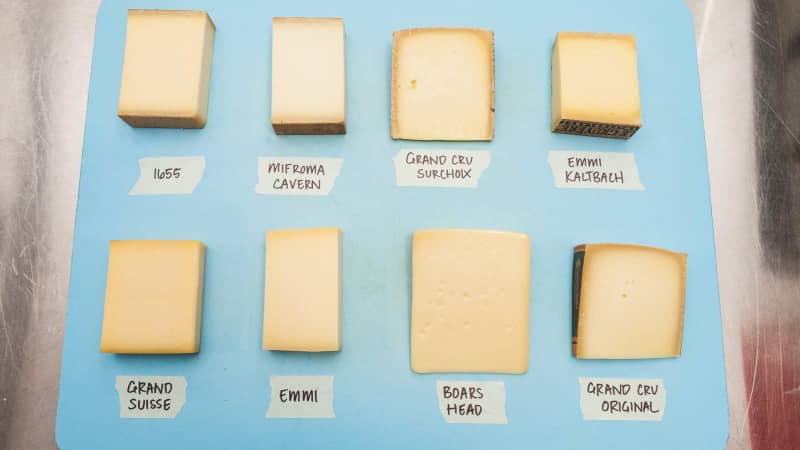Supermarket Brie
Taste Test
The right Gruyère is buttery and complex, is pleasantly firm and dense, and melts like a champ. If you aren’t buying it, you should be.
Published May 1, 2017. Appears in America's Test Kitchen TV Season 18: Pressure Cooker Perfection

What most Americans think of as “Swiss cheese” is the mild, holey stuff called Emmentaler. That cheese is fine for slicing thin and piling on ham sandwiches, but it bears little resemblance to its fellow citizen, Gruyère. The latter, which has been made in the eponymous alpine region of Switzerland for more than 900 years, is pleasantly firm and dense, slightly crumbly, and boasts that faint crystalline crunch that high-quality aged cheeses such as cheddar and Parmesan are known for. Good versions taste deeply nutty and have sweet, fruity tang; nice salinity; and a good bit of earthy funk. Gruyère is also one of a very few cheeses, Swiss or otherwise, that functions just as well in cooked applications as it does on a cheese plate. Scan the test kitchen’s recipe archive and you’ll find roughly 100 recipes featuring it—from breads, soufflés, frittatas, and gratins to scrambled eggs, mashed potatoes, fondue, and French onion soup.
As Gruyère’s stateside popularity has grown over the years, so, too, has its availability in American supermarkets. When we shopped recently, we found eight nationally available options, priced from $14.99 to $23.99 per pound. Five were Swiss imports bearing the Appellation d’Origine Protégée (AOP) seal, meaning they were made according to strict government-mandated rules and quality standards. The other three were domestic facsimiles; two of those, both made by Emmi Roth, stopped calling themselves “Gruyère” several years ago in deference to the Swiss-made cheeses. To find a favorite, we sampled each plain at room temperature, baked in spinach-and-cheese squares, and melted on crostini.
Swiss cheesemakers claim that every part of the rigorous AOP-regulated process contributes to Gruyère’s unique, deeply complex flavor and dense, crystalline texture, starting with the milk itself. It must be raw and from mostly grass-fed cows, since both the Alpine grasses and the bacteria naturally present in unpasteurized milk infuse the cheese with flavor. From there, the milk is mixed with cultures and rennet, which introduce more flavorful bacteria and cause the milk to coagulate into curds, respectively. Then it’s heated in giant copper vats. That particular vessel is important not just because copper heats evenly and responds quickly to changes in temperature but also because copper ions from the surface of the vat leach into the milk and curds and react with compounds in the milk to form desirable and distinct flavor compounds.
Once the curds have formed, they’re transferred to large wheel-shaped molds to be pressed for the better part of a day; turned out and either salted or brined for another ...
The mission of America’s Test Kitchen Reviews is to find the best equipment and ingredients for the home cook through rigorous, hands-on testing.

Kate is a deputy editor for ATK Reviews. She's a culinary school graduate and former line cook and cheesemonger.

This is a members' feature.